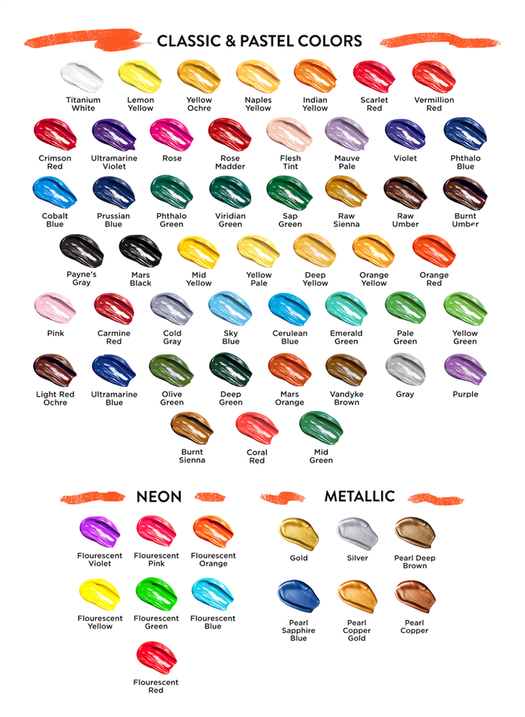Whether or not you decide to dilute your paint, you need to keep a large amount of water handy for cleaning your paintbrushes regularly.
There are ready-to-use paper, cardboard, wood, plywood and canvas media. But you can also decide to use an unprepped medium to which you apply a primer.
– A primer is a substance spread on a medium to prepare it to receive paint. Gesso, which is easy to use, is the most often used primer for acrylics. When dry, it forms an impermeable, very flexible layer.
– Apply the gesso in thin layers with a wide, soft bristle brush. Once dry, sand, then apply a fresh coat perpendicular to the previous one. Your goal is a perfectly smooth, white surface.

Organizing your colors
Organizing your palette is an essential step. Note that there is no one-size-fits-all approach and we all have our own habits. Here are some simple principles you can follow:
– Always start by putting together a list of the shades you’ll need for painting your subject.
– Arrange your colors from lightest to darkest, by “families” (yellow, red, etc.).
– Make sure to always follow the same sequence, whatever your favorite shades happen to be: that way, you can find your colors with your eyes shut!
– Put a large amount of white at one end of the palette, because you’ll be using it more than any other shade.
Trick of the trade
– Acrylics dry very fast, so make sure you only put small amounts of paint on your palette.
– If your colors are drying too fast, add a few drops of water with your paintbrush or use a little atomizer to wet them.
What to Consider When Buying Acrylic Paint
Shopping for acrylics can be daunting, especially with so many brands and variations to choose from. It doesn’t have to be that way!
If you’re a total beginner, it’s a good idea to just get a basic acrylic paint set (plus essential painting supplies, which we’ll also talk about later). Over time, you’ll learn what varieties you prefer and how to select the right paint for the techniques you want to master.
For those who want to get a little more in-depth, here are the factors you need to consider: color, quality, viscosity, permanence, and packaging.
Color

Acrylic paint comes in a wide array of rich and vivid colors. Many art supply stores carry single tubes and sets, with beautiful color selections to suit any project. If you’re going with single tubes, it’s a good idea to get these essential colors: black, white, brown, red, orange, yellow, green, blue, and purple. These will let you mix and create more colors down the line when you need them.
Beginners can also go with acrylic paint sets, which include all the above-mentioned colors plus more gorgeous shades to work with. And if you want to give your painting a unique touch, neon, metallic, and iridescent pigments are also available for an eye-catching finish.
Quality

When shopping for acrylics, you’ll often encounter these terms: artist/professional and student quality. These refer to the “grade” of the acrylic paint.
Artist-quality paint (also known as premium or professional) comes in a wider range of colors and contains more pigment compared to student-quality acrylics. It also has a higher permanence rating, which means that it will stay vibrant for a longer period of time.
Student-quality paints, on the other hand, are more affordable — but may be less vibrant and permanent. These are ideal for craft projects or practice, but it’s better to use professional quality paints if you want to preserve or sell your artworks.
Viscosity

Viscosity refers to the thickness of the paint and is an important factor to consider if you want to try specific techniques. Heavy body acrylics are thick with a similar consistency to oil paints. This lends them well to impasto and other texture techniques. Soft body acrylics are thinner, offering incredible coverage and opacity. These are ideal for adding fine details to your piece or trying wet-on-wet and gradient painting.
You can also buy fluid acrylics for stippling and splattering or high flow acrylics that behave like ink. These viscosities can also be achieved by mixing heavy body paint with a fluid or gel medium, which will make the paint thinner without compromising the pigment quality.
Here at Chalkola, our acrylic paints are heavy-bodied and can be mixed with a variety of mediums to achieve your desired finish. This means more versatility for artists who want to use and master different techniques.
Lightfastness

Lightfastness (aka permanence) is how resistant the paint is when exposed to light. This is especially important for paintings that will be displayed and viewed. Manufacturers have different standards for permanence, but you will often find a lightfastness rating indicated on each paint tube or bottle.
If you buy an acrylic paint set, keep in mind that not all colors in the set will have the same rating. That’s because each pigment has a unique chemical composition, which affects the formula.
A Brief History of Acrylics
Basic Acrylic Painting Supplies





